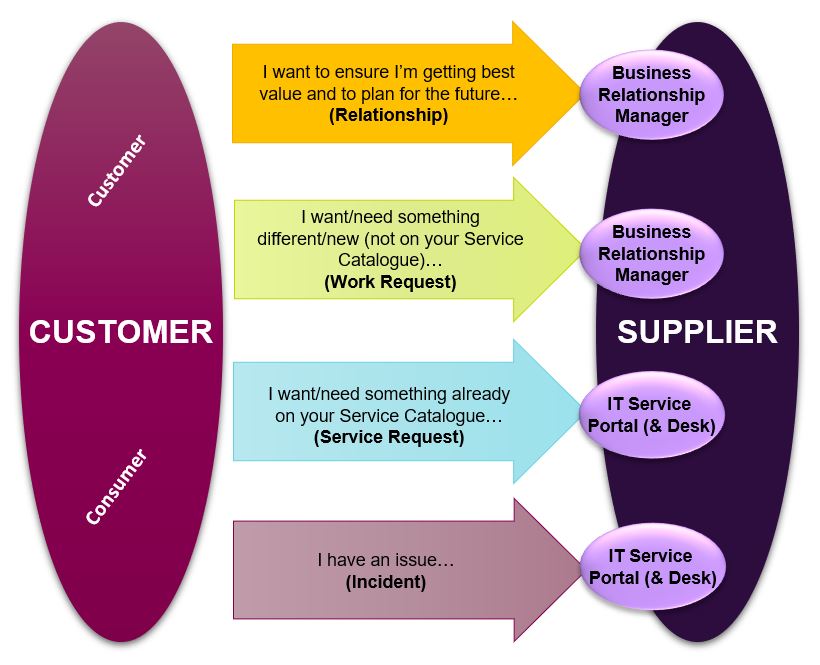Navigating how to “get things done” within organisations. It’s time to simplify!
Share:
Date:
July 2020

key fact
Do you find yourself having to navigate your organisation’s various service teams to “get things done”? Creating clear and simple engagement methods across the enterprise significantly improves effectiveness.
In your organisation, what approach would you take to:
- Purchase and install a desktop application?
- Request a laptop?
- Request a change to a business application?
- Notify IT that the office WiFi has dropped?
- Request permission to attend a training course?
- Change the bank account that you’d like your salary paid in to?
- Obtain permission to recruit?
- Notify the facilities department that toilet cubicle two is blocked?
Even if you can quickly and confidently answer all the above:
- Would your colleagues’ answers match yours?
- How long does it take a new starter to learn?
- How many different tools do you use to raise these requests / issues?
- How many times do you have to chase / escalate?
If you have this well-tuned already, this is a fantastic accomplishment. If you have not, you may find this article beneficial.
One of the base principles of effective Enterprise Service Management is that consumers are not required to navigate Service Providers, be that IT, HR, Facilities, or any team that provides another team with some form of service. Imagine a scenario where anytime you need something from your organisation, you only need to go to one place, regardless as to whether the service is in-sourced, outsourced, or multi-soured. Yet in IT alone we regularly hear:
- “I email Sandy from the app support team directly to get my sales application issue fixed.”
- “I send an email to the firewalls@yourdomain.com shared mailbox to get my firewall changes completed.”
- “I use our purchasing tool to buy a new laptop for my new starter, then the ITSM tool to ask IT to set it up for me.”
- “I call the manager of the desktop team to get a new desktop application installed.”
Sound familiar? It doesn’t need to be like this. With the right organisational design, toolset and approach to your service catalogue (more on this in subsequent articles), the engagement model can be significantly simplified, help your customers, and provide you with a platform to continually improve.
To address this, we recommend the following four-level customer to supplier engagement model, which can be applied to any industry or personal situation; you and your home broadband provider, you in your work life and your IT department, etc.

Note 1 – depending on your organisation, this may need to be expanded to cover the end to end supply chain. The four levels hold true, and we can help ensure you achieve optimal value.
Note 2 – the above covers customer to supplier engagements only. When an interaction has occurred, engagements from the supplier back to the customer could vary depending on the response required, although these can also be simplified.
How many different touch points can you see?
There are only two:
- Business Relationship Manager (albeit, there is likely to be one for each Service Provider e.g. IT, HR, Finance, etc.)
- Service Portal/Desk.
1. Business Relationship Management (BRM)
Looking for something that is not on a Service Provider’s service catalogue? Discuss with your BRM and, if it is something you’d like to continue with, raise a Work Request to progress through wider review, approval (or otherwise), prioritisation, and then delivery (via a Project or Small Enhancement). Simplifying things further, Work Requests can be raised on the same Service Portal as Incidents and Service Requests.
2. Service Portal/Desk
Service Requests should be raised against a clear Service Catalogue. Defined effectively, 90%+ should be logged via the Service Portal. When was the last time you called Amazon to place an order?
Incidents should also be raised against a clear Service Catalogue. Defined effectively, over half of these should be logged via the Service Portal. Consumer preference suggests that some level of over-the-phone engagement will always be required for Incidents.
Further still, most case management tools enable Incidents and Service Requests to be auto-routed to the correct fulfilment / resolver team, and to prompt the raiser to answer service specific questions to enable the team to complete the task first time.
There are 34 IT Service Management practices (ITIL v4). Add in all the teams in your organisation and multiply that be the number of services each team offers, it’s no surprise that engaging with IT (and the wider Enterprise) can be confusing.
Using the four-level customer to supplier engagement model and approach can significantly:
- reduce resolution / fulfilment times and unnecessary effort
- improve resource allocation and reduce dependencies
- reduce tooling complexity and costs
- improve decision making.
All while improving transparency and the customer experience. Sandy from IT will be grateful too!
Mason Advisory has extensive experience in assisting organisations to quickly assess, define, deploy and embed optimal best-fit engagement models, covering organisation design, people, process, tools and reports.
This is the first in a series of three Service Management related articles. Click below to see the other two:
- Article 2 – What is an IT Service? The 7 categories
- Article 3 – What’s in your shop window?
Published: LinkedIn
Disclaimer – opinions expressed in the text belong solely to the author, and not necessarily to the author’s employer or organisation.